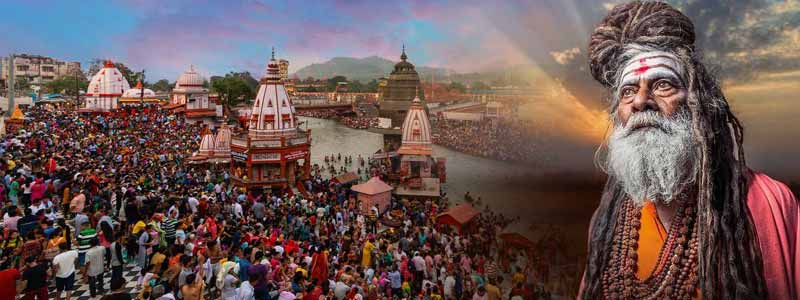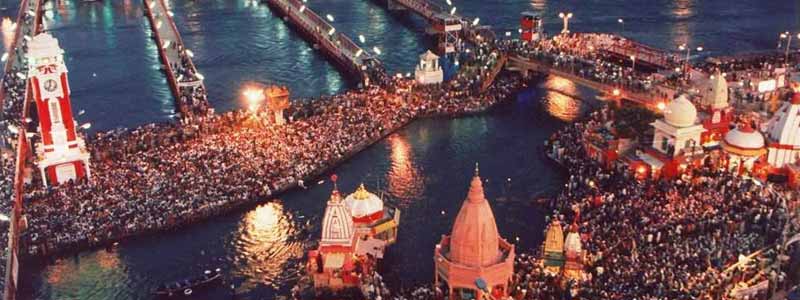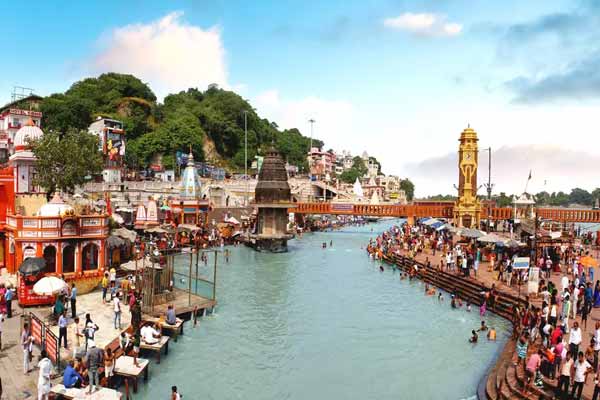10 Best Places to Visit in Haridwar is one of India’s most important religious destinations. The name ‘Haridwar‘ means ‘God’s Gateway.’ It was previously known as Mayapuri and Moksha Dwar. Panch Tirtha refers to a group of five pilgrimage sites in Uttarakhand. Har Ki Pauri, Mansa Devi, Chandi Devi, Ghat, and Kankhal are among them. According to Hindu legends, the Ganga Arti in each pauri plays a vital role. Haridwar is the gateway to the Char Dham, which includes Badrinath, Kedarnath, Gangotri, and Yamunotri. It is said to be one of the four sites where the drips of honey landed during the churning of the sea.
Every evening, hundreds of devotees gather at the Ghats (River Banks) in Haridwar to participate in a series of rites for the iconic Ganga Aarti. Haridwar has a mega-gathering once every twelve years during the world-famous Kumbh Mela, which attracts millions of visitors from all over the country. Haridwar is one of only four places in India that can host the Kumbh Mela, along with Prayagraj, Nashik, and Ujjain.
Because Haridwar is well connected by trains and roads, it also serves as a base location for some of the other tourist cities of Rishikesh and Devprayag. Apart from its religious significance, Haridwar is currently establishing itself as a diversified cultural and spiritual hub. It’s also known for its food and some of the must-try dishes include kachoris at Kashyap Kachoriwala and the aloo puri at Mohanji Puriwale.

History of Haridwar
Haridwar is also known as the gods’ entryway in mythology. According to legend, this city arose when a drop of elixir (Amrit) created by the Gods and devils came to Earth.
Haridwar is also referenced in the Mauryan Empire’s scriptures, which ruled from 322-185 B.C., and following the Mauryan Empire, it was ruled by the Kushan dynasty. 10 Best Places to Visit in Haridwar is also mentioned in the annals of the great Chinese traveller Hiuen Tsang, who visited the city in 629 A.D.
If we go by the scriptures, Haridwar is known by various names, including Kapilasthana (since Maharishi Kapila had his ashram here at one time), Gangadwara, and Mayapuri.

What to Do in Haridwar?
Haridwar, the welcoming intersection of Dev Bhoomi Uttarakhand, is the gateway to the Char Dham. Every year, thousands of people flock to Haridwar to pay their respects to the sacred Ganga. The bustling streets of Haridwar will keep you wandering for hours because there is a new sight to behold at every turn. Rhesus monkeys, on the other hand, are renowned for disturbing people along the ghats. Along with the holy cities of Prayagraj, Ujjain, and Nashik, 10 Best Places to Visit in Haridwar is also the site of the massive Kumbh Mela. Busiest during the religious pilgrimage of Kumbh Mela, Haridwar become a photographer’s paradise because of unique and lively sights seen during this event.
Best Tourist Places at Devo ki Bhoomi – Haridwar
Haridwar lies in Uttarakhand’s Devo ki Bhoomi (Land of God). It is the most prominent Hindu religious tourism destination and one of Uttarakhand’s most frequented destinations, with an estimated 5-10 million visitors each year during the month of Savan ( July- August ). Every day, it hosts the world’s most popular Ganga Ghat, “Har Ki Pauri.” Approximately 10,000 tourists attended Ganga Aarti in the evening. I’ve compiled a list of the Best Famous Places to Visit in Haridwar that you must see during your 10 Best Places to Visit in Haridwar.
Har Ki Pauri
Vishnu is thought to have taken the first step here. Har-ki-pauri denotes Hari’s feet in Hindu scriptures, which was developed. The Ganga Aarti, which is very important to Hindus, takes place here. Pandit Madan Mohan Malaviya began performing Ganga Aarti here in 1910. Every day, Ganga Aarti is performed twice, once in the morning (sunrise, 5.30 to 6.30) and once in the evening (sunset, 5.30 to 6.30). (sunset, 6.00 to 7.00). You must be at the Har Ki Pauri Ghats at least an hour before the evening aarti if you wish to observe a beautiful kind of aarti while sitting on the ferry.
The Pandits perform Ganga Aarti here. After the aarti, you can build a lamp in the Ganges. The ringing of bells during the Ganges coast night aarti, as well as the hundreds of eyes that flow after the aarti, are breathtaking. Bathing in the Ganges is very popular in this location, 10 Best Places to Visit in Haridwar. Every day, between 5,000 and 10,000 devotees dip in the Ganges. This number surpasses 30 thousand during Makar Sankranti, Shivratri, Baisakhi, and Somvati Amavasya, as well as other festivals.
Har ki pauri is located right in the heart of the city. This is the local market, where you can buy fresh fruits and cuisines from the area. There are 2-3 bridges on which you can walk far and wide. Some hotels are at the edge of the ghat where you will have to walk a few minutes for Ganga Aarti.
Mansa Devi Temple
A famous temple of Mansa Devi is located on the hill of Bilwa, Haridwar. It can be reached by a distance of about 3 km from Har-Ki-Pauri, or you can also take a cable car at the entrance, where it climbs to the height of 178 meters to reach the temple of Mansa Devi. Mansa Devi is considered as a form of Parvati ji. Here you can see the beautiful view of the Ganges and 10 Best Places to Visit in Haridwar rivers. The temple is open from 8am to 5pm. It is said that the wishes of those who come here are fulfilled. The devotees bind thread in a tree located here and reach the thread when the validity is completed.
Chandi Devi Temple
Chandi Devi is a temple situated on the Neel Mountain. It is located on a hill at an altitude of 2,900 meters, where you can go 4 km from Har Ki Pauri or cable car (Chandi Devi Udhana Khotla). This temple was built by Adi Shankaracharya (700 – 820 AD). Chandi Devi is considered as a form of Parvati ji. It is said that Shumbha-Nishumbha wanted to marry the goddess, but after rejecting them, Shumbha-Nishumbha sent two demons: Chanda-Munda to fight against Parvati. Goddess Parvati took the form of a powerful Goddess Chandika to fight against them. Chandika Devi slaughtered Chand-Munda and then Shumbha-Nishumbh. This war was only on this Neel Mountain, hence the temple was built here.
Kankhal, Haridwar
Kankhal, one of the Panch Tirths in Haridwar, is a small colony that is home to the renowned Daksha Mahadev Temple and Maa Anandamayi Ashram. The former is dedicated to Lord Shiva and is visited by innumerable devotees, especially during the holy month of Sawan. The latter is a spiritual centre, built in honour of the Bengali mystic leader Maa Anandamayi.
Kankhal is also home to the holy ghat of Kushavarta, which is one of the Panch Tirths and the famous Patanjali Yog Peeth that is probably the largest yoga centres in the world. Pardeshwar Mahadev Temple in Harihar Ashram, located on Kankhal Road, is famous for the unique Parad Shivalinga that is made from 151 kg mercury, 10 Best Places to Visit in Haridwar.
Maya Devi Temple, Haridwar
Completing the trio of Siddh Peeths in Haridwar is Maya Devi Temple, which is dedicated to Goddess Maya, who is the main deity of Haridwar and in reverence, the city was earlier known as Mayapuri. As per mythological literature, the temple has been built on the site where Goddess Sati’s heart and navel fell, 10 Best Places to Visit in Haridwar.
It is one of the oldest temples in the entire country that was built in the 11th century on Har Ki Pauri Ghat. Although the temple is visited by hundreds of devotees daily to seek the goddess’ blessings and get their wishes granted, the footfall increases immensely during Navratri and Kumbh Mela.
Shantikunj, Haridwar
One of the most popular spiritual and moral enlightenment centres in the world is Shantikunj in Haridwar. Established in 1971, it is the headquarters of All World Gayatri Pariwar (AWGP) that has millions of followers across the world. The centre propagates national integration as well as cultural and ethical values apart from spiritual and moral upliftment. Shantikunj also has a research institute (Brahmavarchas Shodh Sansthan) and a residential university (Dev Sanskriti Vishwavidyalaya).
This must-visit attraction has been visited by a number of world-renowned personalities, including Dalai Lama. You can also stay here for free for up to two days, during which you need to take part in all their daily activities, including bhajans and aartis.
Sapt Rishi Ashram, Haridwar
Sapt Rishi Ashram, located on the banks of the river, is one of the popular 10 Best Places to Visit in Haridwar. Along with Hindu devotees, the ashram sees a high footfall of visitors looking for a peaceful site for meditation and yoga. The tranquil ambience of this place is so perfect for meditation that it even attracted the renowned seven sages, and thus got its name – sapt means seven and rishi means sage.
As per mythology, Kashyapa, Vashishta, Atri, Vishwamitra, Jamadagi, Bharadwaja and Gautam – the seven sages were meditating along the banks but were getting disturbed by the sound created by the flowing river and thus captured it. Later, Ganga split the flow into seven streams (Sapt Sarovar) to minimise the noise of gushing water.
Bharat Mata Mandir, Haridwar
Literally meaning Mother India Temple, Bharat Mata Mandir is a unique multi-storey temple in Haridwar that is dedicated to patriots and freedom fighters. Inaugurated by the late Prime Minister Indira Gandhi in 1983, the 180-feet tall temple with 8 floors celebrates the spirit of unity in diversity, which actually reflects the true essence of our great nation.
Each of the eight floors have an individual theme – Bharat Mata dedicated to Mother India, Shoor Mandir dedicated to Indian heroes, Matru Mandir dedicated to renowned women personalities, Sant Mandir dedicated to saints, Assembly Hall reflecting religious harmony, sixth floor dedicated to Goddess Shakti, seventh floor dedicated to Lord Vishnu and eighth floor dedicated to Lord Shiva.
Best Time to Visit Haridwar
The city experiences great weather almost round the year as it is clearly affected by its closeness to the hills. Both summer and winter are the best seasons to plan holidays here. The reason behind this is, during these months the city hosts many religious festivals and events.
Summer :- The season starts from March and lasts until June. The weather of 10 Best Places to Visit in Haridwar during these months remains hot in the daytime and becomes breezy at night. The temperature in summer ranges from 18°C to 40°C. Summer is the best season to enjoy Ramnavmi and Buddha Purnima festivals.
Monsoon :- The city experiences a moderate rainfall during the months of July to September. Sometimes the rainfall can be heavy resulting in the shutdown of various tourist attractions and activities during these months. It is advised to check the weather forecast before planning a trip in the monsoon here.
Winter :- October to February are considered as the months of winter in Haridwar. The weather during this time is quite chilly with the temperature ranges from 6°C to 20°C. Alike summer, winter is also the pleasant season to visit Haridwar.
How To Reach Haridwar
Haridwar is thought to be the stairway to heaven and deliverance for Hindus. Located in the 10 Best Places to Visit in Haridwar district of Uttarakhand, it is a holy destination for Hindu pilgrims and makes for a busy area almost all round the year. Due to this paticular reason it is well connected to majority of the signifiant Indian cities via rail, road or air. Read below to find out more on how to reach Haridwar easily.
By Air : There is no airport in Haridwar. Jolly Grant Airport in Dehradun is the closest one, approximately 37 km away. This domestic airport can easily be reached from any of the major metropolitan Indian cities. Air India Regional, IndiGo, Jet Airways, SpiceJet and Ventura AirConnect have flights to and from Jolly Grant. Alternately, local and international travellers can land at Indira Gandhi International Airport in Delhi (223 km away). Travellers can get to Haridwar from these two airports by bus, taxi/cab or train.
By Road : The journey to Haridwar by road, is a scenic and relaxed one. 10 Best Places to Visit in Haridwar is connected to Chandigarh (205 km), Delhi (210 km), Dehradun (59 km) and Nainital (223 km). Numerous municipal and private buses traverse these roads. Visitors have the option of A/C, non-A/C, luxury vans, cars etc. Tourists driving down should also be alert to the potholes on some parts of the roadway to Haridwar. Hence, it is suggested to drive cautiously.
By Rail : The key railway station is the Haridwar Railway Station. Forming a part of the Northern Railway Zone, it is linked to the big metro cities and tourist capitals in India. Multiple trains to Haridwar depart from Delhi’s H. Nizamuddin Railway Station, taking about 5-6 hours. There are also three overnight services departing from various Delhi railway stations. The most affordable and quickest mode of travel to Haridwar is definitely via train. However, trains do get booked out fast, especially during April (auspicious pilgrimage time), so visitors might find themselves waitlisted, 10 Best Places to Visit in Haridwar.
